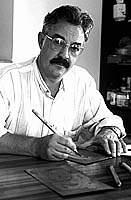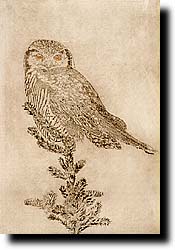
 by Andro Cecovini
by Andro CecoviniEtcher
Etching
Etching is one of the oldest artistic printing techniques invented towards the end of the 15th century. The old masters who used Etching as a specific form of artistic expression include Albrecht Dürer and von Leyda, followed by Il Parmigiano, in the early 16th century. However it is very probable that the need to preserve records of the original drawings that some of the finest craftsmen engraved on helmets and armour, as well as many other ordinary objects, had already led to the idea of the transfer of etchings carried out on metal onto paper as well. The word Acquaforte or Etching comes from the solution of water and nitric acid - or some other corrosive substance - in which the metal plate (copper, zinc, steel) is placed to be corroded by an acid reaction on the metal.
 A classical etching by the artist, who rappresent an owl |
See also: An artist who works in the midst of the Tuscan countryside e How to prepare an etching

FAN-Florence ART News
by
Silvia Messeri & Sandro Pintus
Web
development Mega Review Srl - © 2005 